Green armoured tardigrades (Echiniscidae: Viridiscus), including a new species from the Southern Nearctic, exemplify problems with tardigrade variability research
- PMID: 37770488
- PMCID: PMC10539286
- DOI: 10.1038/s41598-023-40609-4
Green armoured tardigrades (Echiniscidae: Viridiscus), including a new species from the Southern Nearctic, exemplify problems with tardigrade variability research
Abstract
Ranges of tardigrade intraspecific and interspecific variability are not precisely defined, both in terms of morphology and genetics, rendering descriptions of new taxa a cumbersome task. This contribution enhances the morphological and molecular dataset available for the heterotardigrade genus Viridiscus by supplying new information on Southern Nearctic populations of V. perviridis, V. viridianus, and a new species from Tennessee. We demonstrate that, putting aside already well-documented cases of significant variability in chaetotaxy, the dorsal plate sculpturing and other useful diagnostic characters, such as morphology of clavae and pedal platelets, may also be more phenotypically plastic characters at the species level than previously assumed. As a result of our integrative analyses, V. viridianus is redescribed, V. celatus sp. nov. described, and V. clavispinosus designated as nomen inquirendum, and its junior synonymy with regard to V. viridianus suggested. Morphs of three Viridiscus species (V. perviridis, V. viridianus, and V. viridissimus) are depicted, and the implications for general echiniscid taxonomy are drawn. We emphasise that taxonomic conclusions reached solely through morphological or molecular analyses lead to a distorted view on tardigrade α-diversity.
© 2023. The Author(s).
Conflict of interest statement
The authors declare no competing interests.
Figures
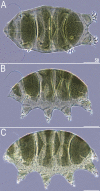

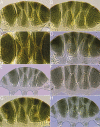


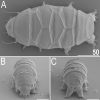


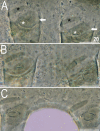
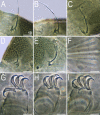
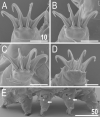

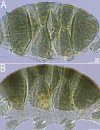


Similar articles
-
The importance of being integrative: a remarkable case of synonymy in the genus Viridiscus (Heterotardigrada: Echiniscidae).Zoological Lett. 2021 Nov 20;7(1):13. doi: 10.1186/s40851-021-00181-z. Zoological Lett. 2021. PMID: 34801080 Free PMC article.
-
Two new species of Tardigrada from moss cushions (Grimmia sp.) in a xerothermic habitat in northeast Tennessee (USA, North America), with the first identification of males in the genus Viridiscus.PeerJ. 2020 Nov 23;8:e10251. doi: 10.7717/peerj.10251. eCollection 2020. PeerJ. 2020. PMID: 33282552 Free PMC article.
-
Atlas of the Echiniscidae (Heterotardigrada) of the Worldpart I: West Palaearctic Echiniscus species.Zootaxa. 2023 Sep 14;5344(1):1-72. doi: 10.11646/zootaxa.5344.1.1. Zootaxa. 2023. PMID: 38221356
-
Rough backs: taxonomic value of epicuticular sculpturing in the genus Milnesium Doyère, 1840 (Tardigrada: Apochela).Sci Rep. 2022 Jun 14;12(1):9857. doi: 10.1038/s41598-022-10758-z. Sci Rep. 2022. PMID: 35701458 Free PMC article. Review.
-
Advances in bioinformatic approaches to tardigrade phylogeny.Comput Biol Chem. 2024 Dec;113:108226. doi: 10.1016/j.compbiolchem.2024.108226. Epub 2024 Sep 26. Comput Biol Chem. 2024. PMID: 39368175 Review.
Cited by
-
Patterns of sexual dimorphism in the armoured tardigrades.Biol Lett. 2024 Sep;20(9):20240301. doi: 10.1098/rsbl.2024.0301. Epub 2024 Sep 11. Biol Lett. 2024. PMID: 39255843
-
An evaluation of thermal tolerance in six tardigrade species in an active and dry state.Biol Open. 2024 Oct 15;13(10):bio060485. doi: 10.1242/bio.060485. Epub 2024 Sep 25. Biol Open. 2024. PMID: 39229830 Free PMC article.
-
A first look into moss living tardigrades in boreal peatlands.Ecol Evol. 2024 Aug 1;14(8):e70045. doi: 10.1002/ece3.70045. eCollection 2024 Aug. Ecol Evol. 2024. PMID: 39091332 Free PMC article.
References
-
- Degma, P. & Guidetti, R. Actual checklist of Tardigrada species, 42nd edn. Accessed 15th April 2023. 10.25431/11380_1178608 (2023).
-
- Marcus E. Zur Anatomie und Ökologie mariner Tardigraden. Zoologische Jahrbücher abteilung für Systematik Ökologie und Geographie der Tiere. 1927;53:487–558.
-
- Kristensen RM. Generic revision of the Echiniscidae (Heterotardigrada), with a discussion of the origin of the family. In: Bertolani R, editor. Biology of Tardigrades. Selected Symposia and Monographs U.Z.I. Mucchi; 1987. pp. 261–335.
-
- Fontoura P, Bartels PJ, Jørgensen A, Kristensen RM, Hansen JG. A dichotomous key to the genera of the marine heterotardigrades (Tardigrada) Zootaxa. 2017;4294(1):1–45. doi: 10.11646/zootaxa.4294.1.1. - DOI
MeSH terms
Grants and funding
LinkOut - more resources
Full Text Sources
Research Materials

